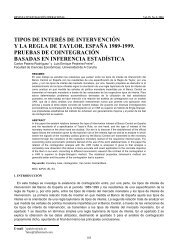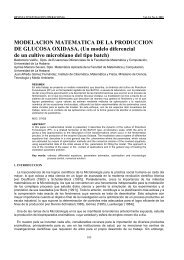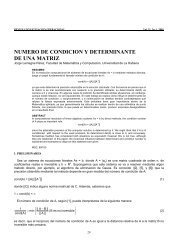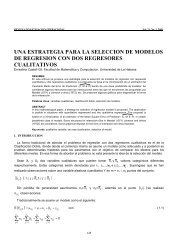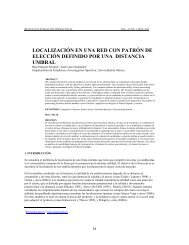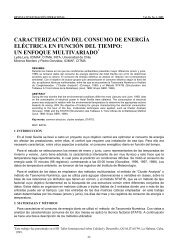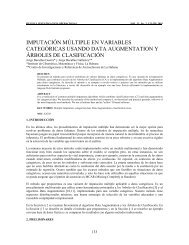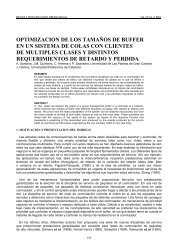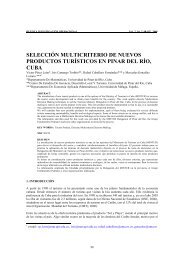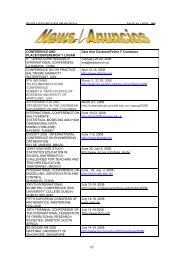nuevo algoritmo para la multiplicacion de matrices booleanas
nuevo algoritmo para la multiplicacion de matrices booleanas
nuevo algoritmo para la multiplicacion de matrices booleanas
You also want an ePaper? Increase the reach of your titles
YUMPU automatically turns print PDFs into web optimized ePapers that Google loves.
REVISTA INVESTIGACION OPERACIONAL VOL.34, , NO. 2, 175-178, 2013<br />
Noveda<strong>de</strong>s <strong>de</strong> software/New softwares<br />
NUEVO ALGORITMO PARA LA<br />
MULTIPLICACION DE MATRICES BOOLEANAS<br />
P. Freyre 1 y N.Díaz<br />
Facultad <strong>de</strong> Matemática y Computación, Universidad <strong>de</strong> La Habana, Cuba.<br />
ABSTRACT<br />
In this paper is shown an algorithm about the multiplication of nxn invertibles boolean square matrixes. The algorithm has<br />
as novelty that the operations that this algorithm perform are addition and multiplications in the finite field GF(2) and<br />
multiplications between polynomials modulo a primitive polynomial, the polynomials belongs to GF(2) [x].<br />
MSC: 65F05<br />
KEYWORDS: <strong>matrices</strong> fast multiplication, <strong>matrices</strong> on a finite field, algorithm for <strong>matrices</strong>.<br />
RESUMEN<br />
En el presente artículo se muestra un <strong>algoritmo</strong> <strong>para</strong> <strong>la</strong> multiplicación <strong>de</strong> <strong>matrices</strong> <strong>booleanas</strong> cuadradas nxn invertibles. El<br />
<strong>algoritmo</strong> tiene como novedad que <strong>la</strong>s operaciones que se realizan son sumas y <strong>multiplicacion</strong>es en el campo finito GF(2)<br />
y multiplicación <strong>de</strong> polinomios módulo un polinomio primitivo, los polinomios pertenecen a GF(2)[x].<br />
1. INTRODUCCIÓN<br />
La búsqueda <strong>de</strong> <strong>nuevo</strong>s y eficientes <strong>algoritmo</strong>s <strong>para</strong> multiplicar <strong>matrices</strong> es un área <strong>de</strong> constante<br />
investigación por parte <strong>de</strong> <strong>la</strong> comunicada científica. En 1967 S. Winograd <strong>de</strong>scubre que <strong>la</strong> multiplicación<br />
<strong>de</strong> <strong>matrices</strong> pue<strong>de</strong> realizarse con menos <strong>multiplicacion</strong>es a <strong>la</strong>s <strong>de</strong>l método tradicional. En 1968 V.<br />
Strassen encuentra una manera más eficiente <strong>para</strong> multiplicar dos <strong>matrices</strong> 2x2 (Strassen V. (1969)y<br />
Knuth E. D. (1981)). Los trabajos <strong>para</strong> mejorar <strong>la</strong> complejidad en <strong>la</strong> multiplicación <strong>de</strong> <strong>matrices</strong> han<br />
continuado y nuevas propuestas <strong>de</strong> <strong>algoritmo</strong>s se han realizado. Strassen V. (1969), Knuth E. D. (1981),<br />
Schonhage A. (1981), Pan V. Y. (1984), Coppersmith D. and Winograd S. (1990), Highman N. J.<br />
(1996) y Majan M. and Vinay V. (1997).<br />
El presente trabajo tiene como objetivo exponer, programado en Mathematica, un <strong>nuevo</strong> <strong>algoritmo</strong> <strong>para</strong><br />
multiplicar <strong>matrices</strong> <strong>booleanas</strong> cuadradas nxn e invertibles que tiene como novedad, que <strong>la</strong>s operaciones<br />
que se realizan son sumas y <strong>multiplicacion</strong>es en GF(2) y <strong>multiplicacion</strong>es <strong>de</strong> polinomios módulo un<br />
polinomio primitivo, los polinomios pertenecen a GF(2)[x] Freyre P, Díaz N y Morgado E. R. (2009).<br />
En el trabajo se dan 4 ejemplos <strong>de</strong> corrida <strong>de</strong>l <strong>algoritmo</strong>. Los polinomios primitivos que se utilizan se<br />
encuentran en Peterson W.W. y Weldon J. E. (1972), Golomb W. S. (1982) y Lidl R. y Nie<strong>de</strong>rreiter H.<br />
(1994).<br />
2. MULTIPLICACION DE MATRICES.<br />
En el programa tenemos que:<br />
n – Es el tamaño <strong>de</strong> <strong>la</strong> matriz.<br />
lpp – Es <strong>la</strong> lista <strong>de</strong> polinomios primitivos gi(x)GF(2)[x], i {1…n}, a utilizarse en el <strong>algoritmo</strong>,<br />
representados en forma <strong>de</strong>scen<strong>de</strong>nte según su grado, y se calcu<strong>la</strong>n con anterioridad. Los mismos pue<strong>de</strong>n<br />
ser seleccionados arbitrariamente.<br />
1 pfreyre@matcom.uh.cu<br />
175
h – Matriz <strong>de</strong> tamaño ninvertibles.<br />
t – Matriz <strong>de</strong> tamaño n invertibles.<br />
m – Matriz resultante <strong>de</strong> multiplicar h por t, m= h × t.<br />
ALGORITMO PARA LA MULTIPLICACION DE MATRICES<br />
Programación <strong>de</strong>l <strong>algoritmo</strong>.<br />
Clear[Creavbc]<br />
Creavbc[n_,i_,v_,vbc_,lpp_]:=<br />
Block[{x=0,t,z,y=PadLeft[{},n]},<br />
z =lpp[[i]][Take[vbc[[i]],{i,n}]];<br />
t = lpp[[i]][Take[y,{i,n}]];<br />
If[TrueQ[z[[1]] t[[1]]],t=lpp[[i]][Take[v,{i,n}]]*(z^-1);<br />
If[TrueQ[t 0],t=lpp[[i]][Take[y,{i,n}]]];<br />
x=lpp[[1]][Take[v,{1,i-1}]] -<br />
lpp[[1]][Take[vbc[[i]],{1,i-1}]]*lpp[[1]][t[[1]][[{1}]]];<br />
];<br />
If[TrueQ[x 0],x=lpp[[1]][y]];<br />
Return[Join[Take[x[[1]],{1,i-1}],t[[1]]]];<br />
]<br />
Clear[Fpolinomial]<br />
Fpolinomial[n_,m_,lpp_]:=<br />
Block[{vbc={},i,j,vec,y=PadLeft[{},n]},<br />
For[j=1, j
Ejemplo 2: Dados los polinomios primitivos:x^4 + x + 1, x^3 + x^2 + 1, x^2 + x + 1,<br />
x + 1.<br />
REFERENCIAS<br />
1 COPPERSMITH, D. and WINOGRAD, S. (1990):Matrix multiplication via Arithmetic<br />
progressions. J. Symbolic Comput. 9, 251_280.<br />
2 FREYRE, P, DÍAZ, N. y MORGADO, E. R. (2009): Some algorithms re<strong>la</strong>ted to<br />
<strong>matrices</strong> with entries in a finite field. Journal of Discrete Mathematical Sciences &<br />
Cryptography. Vol. 12, No. 5, pp. 509–519. India.<br />
3 GOLOMB, W. S. (1982): Shift Register Sequences. Aegean Park Press. California.<br />
4 HIGHMAN, N. J. (1996): Accuracy and Stability of Numerical Algorithms.<br />
SIAM. Phi<strong>la</strong><strong>de</strong>lphia.<br />
5 KNUTH, E. D. (1981): The Art of Computer Programming. Vol 2. Addison – Wesley. 2da ed. , N.<br />
York.<br />
6 LIDL, R. Y. And NIEDERREITER, H. (1994): Introduction to Finite Fields and their<br />
Applications. Cambridge University. New York.<br />
7 MAJAN, M and VINAY V. (1997): Determinant: Combinatorics, Algorithms, and Complexity.<br />
http://cjtcs.cs.uchicago.edu/articles.<br />
8 PAN, V. Y.(1984): How can we speed-up matrix multiplication?, SIAM. Rev. 26, 393_415.<br />
9 PETERSON, W.W and WELDON, J. E. (1972): Error – Correcting Co<strong>de</strong>s, 2ed. John Wiley and<br />
Sons, Inc. New York.<br />
10 SCHONHAGE, A. (1981): Partial and total matrix multiplication. SIAM J. Comput.10,<br />
434_456.<br />
11 STRASSEN, V. (1969): Gaussian elimination is not optimal. Num Math. 13, 354_356.<br />
178



